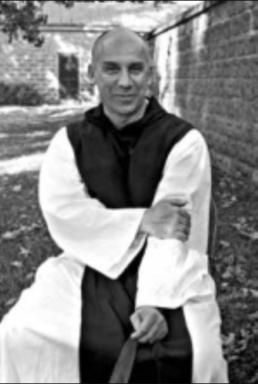These life stories may contain descriptions of childhood trauma and abuse, as well as images, voices and names of people now deceased. If you need help, you can find contact details for some relevant support services on our support page.
Catholic author, Thomas Merton (1915-1968), spent time in kinship care and foster care as a child.
Thomas James Merton’s American mother, Ruth, died when he was six. Thomas and his younger brother, John Paul (1918-1943), went to live with their maternal grandparents while their mother was dying and continued to live there for several months after her death.
Thomas’ New Zealand-born father, Owen Merton, then collected Thomas (but not John Paul who continued to live with his grandparents until their death) and took the child to Bermuda. Owen Merton was an aspiring artist and, according to Thomas Merton, was freed from the responsibility of providing for his family—by landscape gardening—after the death of his wife and able to practice his art.
Owen Merton often left young Thomas with friends while he went off to different areas of Bermuda to paint landscapes, and even to return to the United States for an exhibition in New York. After the exhibition was over, Thomas was returned to his grandparents in America while Owen traveled to France.
In 1925, Owen collected his son and the two traveled to France. Eighteen months later, Thomas was deposited in a boarding school while his father traveled and painted.
Owen Merton took his son to England in 1928 and an aunt took on the responsibility for finding appropriate schools and housing Thomas during holidays.
Owen Merton died in England in 1931 of a brain tumour and the guardianship of Thomas transferred to a long-term medical friend of Owen’s based in London. By then Thomas was sixteen. He finished school in England but hated Cambridge University – which was where he began exploring Catholicism – so completed his university education back in America at Columbia University.
Thomas Merton was sanguine about his father’s parenting, writing:
It is almost impossible to make much sense out of the continual rearrangement of our lives and our plans from month to month in my childhood. Yet every new development came to me as a reasonable and worthy change. Sometimes I had to go to school, sometimes I did not. Sometimes Father and I were living together, sometimes I was with strangers and only saw him from time to time. People came into our lives and went out of our lives. We had now one set of friends, now another. Things were always changing. I accepted it all. Why should it ever have occurred to me that nobody else lived like that? To me, it seemed as natural as the variations of the weather and the seasons (54).
For around twelve months from 1940 Merton taught English at St. Bonaventure College in New York. Then, in 1941, he was accepted as a postulant at the Abbey of Gethsemani, a Trappist monastery in Kentucky and part of the Order of Cistercians of the Strict Observance, “the most Roman Catholic monastic order” (Thomas Merton Center).
Gethsemani was Merton’s home for twenty-seven years.
Merton published his first book, Thirty Poems, in 1944. This was followed by two more before, in 1948, he published the popular The Seven Story Mountain and became famous.
Merton continued writing on a range of topics until his death, leading to several observations that Merton’s writing contributed significantly to the prosperity of Gethsemani. There have also been many posthumous publications.
Merton engaged in contemporary politics through his writing.
...[He] was a strong supporter of the nonviolent civil rights movement, which he called “certainly the greatest example of Christian faith in action in the social history of the United States.” For his social activism Merton endured severe criticism, from Catholics and non-Catholics alike, who assailed his political writings as unbecoming of a monk (Thomas Merton Center).
Thomas Merton died in Thailand while attending an ecumenical conference in Bangkok. In his later years, Merton had become increasingly interested in other, particularly Eastern religions and this was his first extended venture beyond the Abbey since 1941.
References:
Hillis, Gregory. “Thomas Merton, the problem of war and the character of Christian nonviolence.” ABC Religion & Ethics, 29 January 2019. https://www.abc.net.au/religion/thomas-merton-the-problem-of-war-and-christian-nonviolence/10757632
Merton, Thomas. The Seven Story Mountain. An Autobiography of Faith. Boston, Mass: Mariner Books, 1998.
“Thomas Merton 1915-1968.” Poetry Foundation. https://www.poetryfoundation.org/poets/thomas-merton
“Thomas Merton’s Life and Work”. The Thomas Merton Center at Bellarmine University http://merton.org/chrono.aspx
Image available here.
